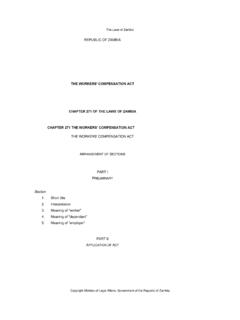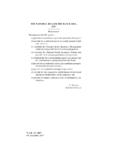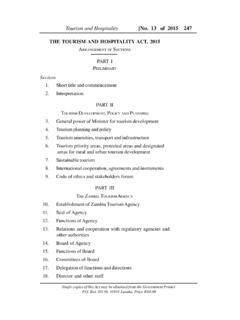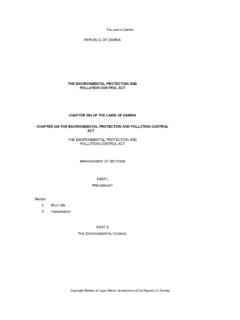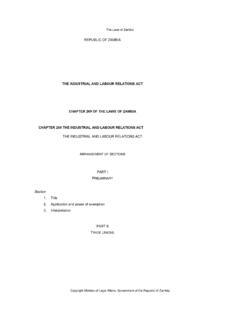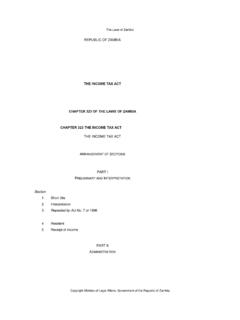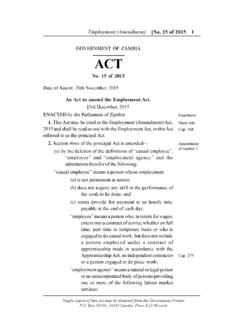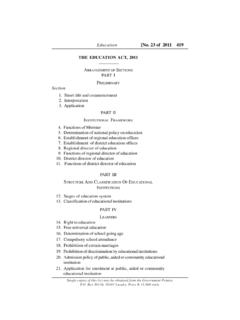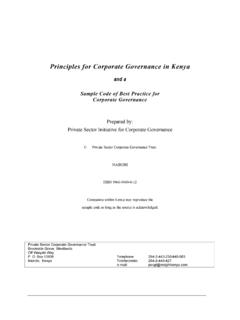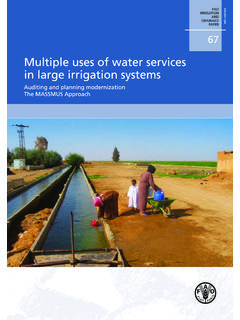Transcription of L A S S E MBLY
1 PUBLIC FINANCIAL MANAGEMENT HANDBOOK for Members of Parliament and StaffiPUBLIC FINANCIAL MANAGEMENT HANDBOOKfor Members of Parliament and StaffRepublic of ZambiaSupport to the National Assembly of Zambia Project Component of the European Union Support to Public Financial Management, Accountability and Statistics Programme. October 2017 NATIONAL ASSEMBLY OF ZAMBIAPUBLIC FINANCIAL MANAGEMENT HANDBOOK for Members of Parliament and StaffiThe National Assembly of Zambia performs four core functions, namely law-making, representation, budget scrutiny and approval, and oversight. Its authority is derived from the Constitution of Zambia (Amendment) Act No. 2, 2016, which states that the representation of the will of the people and the legislative and oversight authority of the Republic are vested in and exercised by the National Assembly has the formal powers to keep the Executive accountable for its actions and policies, including its management of public financial resources, the challenge is to use this mandate to effectively ensure that the Executive adheres to prudent public financial management principles and fiscal policy targets, including maintaining aggregate fiscal discipline and ensuring that public resources are used equitably, efficiently, effectively and accountably.
2 The National Assembly has for some time been undertaking reforms in order to strengthen the performance of its constitutional functions, and its present Strategic Plan 2015-2019 sets out strategic objectives for a further strengthening of its capacity within its core functions. As part of this process, the National Assembly is implementing the European Union s Support to the National Assembly of Zambia Project, which aims at strengthening the ability of the National Assembly of Zambia to perform its role as the apex of public financial management and budget accountability purpose of this Handbook, developed under the auspices of the European Union Project, is to provide a toolkit for the strengthening of the National Assembly in the performance of its mandate in public financial management. It provides a comprehensive introduction to the concept, objectives and scope of public financial management and serves as a reference and self-training manual for Members of Parliament and Staff of the National Assembly on issues relevant to their specific functions.
3 Moreover, the Handbook serves as a framework for the design of future capacity building interventions initiated by the National Assembly for both Members and Handbook does not represent an assessment of the effectiveness of the country s current financial management setup nor operational performance. Any financial management system is undergoing periodic reviews overtime to improve its effectiveness. The Zambian PFM system is no exception. Some parts of the system works better than others. However, the National Assembly recognises that Government has embarked on series of reforms aiming at improving the efficiency, effectiveness, transparency and accountability of the current system. The ongoing implementation of the Treasury Single Account; the Integrated Financial Management Information System; Output-Based Budgeting ; the expected planning and budgeting legislation and the revisions to the Public Finance Act are examples of the reforms.
4 Let me take this opportunity to thank all the stakeholders - the academia, governmental and non-governmental think tanks, national public financial management experts and practitioners and National Assembly staff members - for their valuable contributions and lively participation during the course of developing the Handbook. Let me also take this opportunity to thank the Ministry of Finance for taking time to provide input and for supporting the publishing of the document. Finally, I extend my gratitude to the European Union without whose support this Handbook would have been a challenge to write and publish. It is my hope that Members and Staff of Parliament will employ the Handbook as an essential aid in public financial management Hon. Justice Dr. Patrick Matibini, SC., MP Speaker of the National Assembly of ZambiaForewordiiPUBLIC FINANCIAL MANAGEMENT HANDBOOK for Members of Parliament and StaffForeword iAcronyms ivIntroduction 1 MODULE I.
5 INTRODUCTION AND BACKGROUND TO PUBLIC FINANCIAL MANAGEMENT 3 Chapter 1. The meaning, objectives and content of public financial management 5 Chapter 2. Fiscal decentralisation and the fiscal relationship between the Central Government, Parliament and sub-national governments 13 Chapter 3. Good financial governance and political economy 21 MODULE II. INSTITUTIONAL, POLICY AND LEGAL FRAMEWORK 29 Chapter 4. Legislative and regulatory framework for managing public finances 31 Chapter 5. The national integrated planning and budgeting framework 37 Chapter 6. Purpose and structure of public budgets 41 Chapter 7. Government accounting and reporting standards and practices 49 Chapter 8. Key players and their roles and responsibilities in PFM 59 Chapter 9. Parliament s role during the budget cycle 67 MODULE III.
6 BUDGET FORMULATION STAGE 75 Chapter 10. Choice of budget methods 77 Chapter 11. The role of communities in the planning and budgeting process, including project identification at community and constituency levels and MPs role in the process 83 Chapter 12. The national budget preparation process 91 Chapter 13. Resource mobilisation and design of revenue systems 97 Chapter 14. Understanding the Green Paper (Medium-Term Expenditure Framework) 105 MODULE IV. BUDGET SCRUTINY AND APPROVAL STAGE 111 Chapter 15. The coverage and classification of the budget (understanding the structure and contents of the Yellow Book) 113 Chapter 16. Policy and budget analysis as a tool to inform the political debate and decision making 127 Chapter 17. Analysis of the linkages between revenues, sector policies and budget allocations, and between economic growth and poverty reduction 135 Chapter 18.
7 Analysis of the relationship between fiscal and economic policies and variables 147 Chapter 19. Liabilities and assets management 155 Chapter 20. Checklist for political scrutiny of the Green Paper and the Yellow Book 161 Table of ContentsPUBLIC FINANCIAL MANAGEMENT HANDBOOK for Members of Parliament and StaffiiiMODULE V. BUDGET EXECUTION 167 Chapter 21. Public Procurement 169 Chapter 22. Public investment management 177 Chapter 23. Public sector payroll management 185 Chapter 24. Revenue collection 191 Chapter 25. Cash-flow management, including the Treasury Single Account 197 Chapter 26. Debt management 203 Chapter 27. In-year financial and non-financial reporting 211 Chapter 28. Budget follow-up 217 Chapter 29. Internal control and audit 225 Chapter 30. Oversight of aggregate fiscal risk from other public sector entities, in particular state-owned enterprises (SOEs) 231 Chapter 31.
8 Managing extra budgetary funds 237 Chapter 32. Tools for budget analysis 241 MODULE VI. POST BUDGET IMPLEMENTATION STAGE 247 Chapter 33. Understanding the structure and contents of the End-of-Year Financial Report ( The Blue Book ) 249 Chapter 34. Purpose, scope and impact of the reports of the Auditor General and oversight operations of the Public Accounts Committee (PAC) 259 Chapter 35. Performance auditing, including examination of the impact of spending on service delivery, economic growth and poverty reduction. 265 Annex I: Glossary 271ivPUBLIC FINANCIAL MANAGEMENT HANDBOOK for Members of Parliament and StaffABBA ctivity-Based BudgetingAGOA ccountant General s OfficeBOPB alance of PaymentBOZBank of ZambiaCAADPC omprehensive Africa Agriculture Development ProgrammeCACGC ommonwealth Association of Corporate GovernanceCFConsolidated FundCOFOGC lassification of Functions of GovernmentCOMESAC ommon Market for Eastern & Southern AfricaCPIAC ountry Policy and Institutional AssessmentCSOC entral Statistical OfficeCSOC ivil Society OrganisationDDCCD istrict Development Coordinating CommitteeDFIDD epartment for International DevelopmentDSADebt Sustainability AnalysisEUEuropean UnionFRAFood Reserve AgencyGFSMG overnment Finance Statistics ManualGAAPG enerally Accepted Accounting PracticesGFSG overnment Finance StatisticsHRHuman ResourceIBPI nternational Budget PartnershipICTI nformation and
9 Communication TechnologyIDMI nvestment and Debt Management UnitIFACI nternational Federation of AccountantsIFMISI ntegrated Financial Management Information SystemIMFI nternational Monetary FundIPSASI nternational Public Sector Accounting StandardLGEFL ocal Government Equalisation FundLICsLow-Income CountriesLMICL ower Middle Income CountryMoFMinistry of FinanceMOUM emorandum of UnderstandingMPSAsMinistries, Provinces and Spending AgenciesMTEFM edium-Term Expenditure FrameworkNGONon-Governmental OrganisationOBBO utput-Based BudgetingOECDO rganisation for Economic Cooperation and DevelopmentPACRAP atents and Company Registration AgencyPBOP arliamentary Budget OfficePCIPer Capita IncomePDDCP rovincial Development Coordinating CommitteePEFAP ublic Expenditure and AccountabilityPEMFAP ublic Expenditure Management and Financial Accountability ProgrammePERP ublic Expenditure ReviewPFMP ublic Financial ManagementPIMP ublic Investment ManagementPMECP ayroll Management and Establishment Control PPPP ublic-Private-PartnershipPSCP ublic Sector CommitteePSSDD epartment for Payroll Management and Establishment Control Support ServicesRATSARoad Transport and Safety AgencySADCS outhern Africa Development CommunitySMES mall and Medium EnterpriseSOEsState-Owned EnterprisesTSAT reasury Single
10 AccountUNCDFU nited Nations Capital Development FundVATV alue Added TaxWBWorld BankZMWZ ambian KwachaZPPAZ ambia Public Procurement AuthorityZRAZ ambia Revenue AuthorityAcronymsPUBLIC FINANCIAL MANAGEMENT HANDBOOK for Members of Parliament and Staff1 This Handbook on Public Financial Management (PFM) for Members of Parliament and Staff of the National Assembly contains 35 chapters grouped under six modules. While the first two modules con-cern themselves with topics of a general and crosscutting nature, including a general introduction to the concept of public financial management and the institutional, policy and legal framework for public financial management in Zambia, the other four modules are structured along the budget cycle, encom-passing the budget formulation stage, the budget scrutiny and approval stage, the budget execution stage and the post budget implementation stage.
